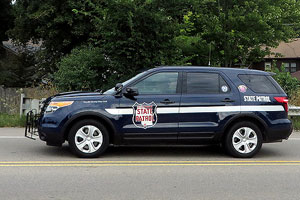Wisconsin Using Grants to Reduce Crashes

For a third straight year, Wisconsin’s State Patrol has received federal and state funding in hopes of continuing to reduce large truck crashes in the state. The yearlong grants of nearly $500,000, which boosted the three-year total over $700,000, took effect Oct. 1.
The State Patrol was prompted to apply for the grant in 2014 because of the shocking jump in large truck crashes in Wisconsin from 5,839 in fiscal 2012 to 7,458 in fiscal 2014.
“We had seen an increase in crashes involving commercial motor vehicles, a lot of them stemming from crashes involving frac mining and transportation in the northern and central part of the state,” State Patrol Lt. Karl Mittelstadt told Transport Topics.
While much of the focus of the enhanced CMV enforcement has been on dump trucks transporting frac sand — which is produced in the hydraulic fracking process — from mines in 12 counties in central and northwest Wisconsin, Class 8 trucks also will be monitored from the air and on the ground.
“It seems there’s a focus on frac-sand operators, which are dump trucks, but there’s another program aimed at high-traffic corridors with commercial motor vehicles,” Wisconsin Motor Carriers Association President Neal Kedzie noted. “I’m being told that they’re not targeting our carriers; that they’re looking for actual violations as they occur … but I could see where this could wind up being random pull-overs. I certainly hope that won’t occur to a large degree. I certainly hope that they’re focusing on bad behaviors rather than just pulling people over and pulling them out of service.”

During fiscal 2015, the first year that the grant provided the funds for the extra law enforcement presence, there were 7,072 large truck crashes in Wisconsin. Using preliminary data from Wisconsin’s Department of Transportation, that figure slipped again to 7,007 in fiscal 2016, which ended Sept. 30.
“I’m happy to see that going in the right direction,” Mittelstadt said. “We’re always looking at ways to get more officers on the road to combat aggressive driving. We have 30 details in 12 counties associated with frac transportation and 280 details in 28 of our highest CMV-related crash counties. This money allows us to run 310 additional details, upwards of 9,000 additional officer hours on the road. Now that fuel prices are increasing, frac transportation is declining, [but] our primary focus isn’t necessarily commercial motor vehicle drivers driving aggressively. It’s cars driving aggressively around the trucks.”
Kedzie agreed on that point.
“This industry has put such an emphasis on crash reductions that our carriers are saying, ‘We’re not the problem. It’s the civilian passenger drivers,’ " Kedzie said. “We didn’t even know about this program until we received the press release. There’s sort of a feeling that our carriers are being unnecessarily targeted. Our carriers are concerned about random stops that interfere with their hours of service. When they’re off the road, they’re not making money.”
Mittelstadt said the State Patrol wants to educate drivers, not punish them.
“It’s not all about writing tickets,” said Mittelstadt, whose colleagues are especially on the lookout for cellphone use and texting behind the wheel. “We want drivers to understand why they’re being stopped. We ask why they were speeding, why they were following too close. If they’re following a couple of lengths behind a semi at 70 miles per hour, they can’t see what’s in front of them.”



